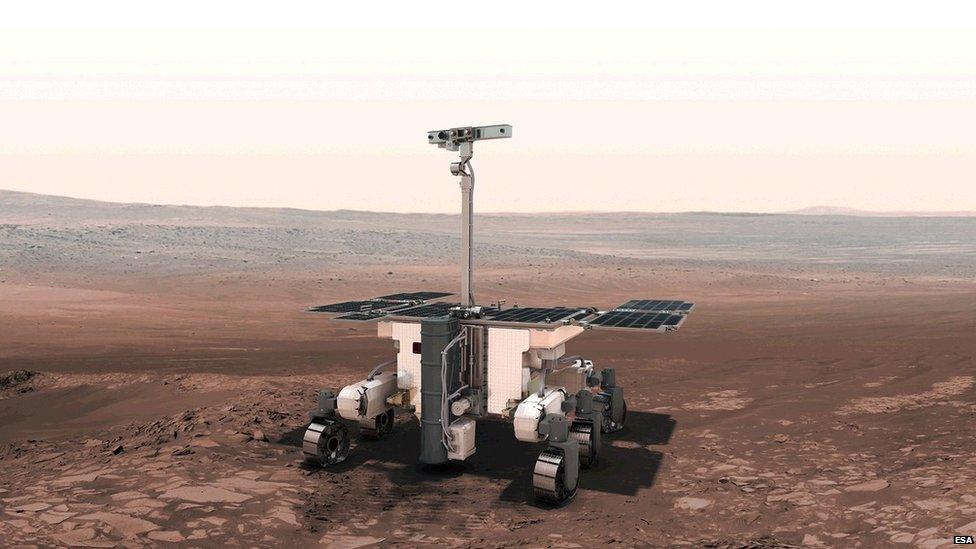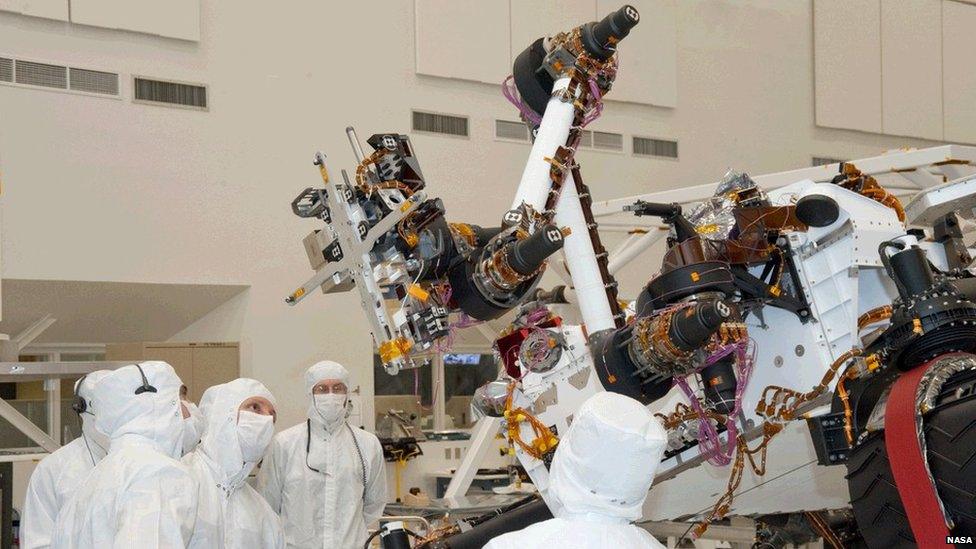The great 'Mars bake-off' begins
- Published

Public webcams mean you'll be able to follow the assembly of the Mars rover from anywhere in the world
The UK aerospace laboratory in which Europe's ExoMars rover will be assembled is about to undergo a three-month deep-clean.
Just built at Airbus Defence and Space in Stevenage, the facility must be made spotless before any robot parts are brought in.
ExoMars will search for signs of past and present life on the Red Planet in 2019, and scientists will need to be sure that any detection is real and not the result of some bugs carried from Earth.
The selfie at the top of the page has me wearing normal clothing; the next time I get to go in the cleanroom it will be in the full "bunny" suit, with hood, mask, shoes and gloves.
Before that can happen, the big sterilisation "bake-off" must happen, starting this coming week.
That's what it's called, but bake-off is really a bit of a misnomer because no heat is actually involved.
Instead, technicians will start running a special air-filtration system, in tandem with regular disinfection, to try to reduce the quantity of spores (bacteria, mould, etc) present in the lab.
"We're classified as a Class 8, Highly Controlled cleanroom," says Paul McMahon, Airbus's ExoMars project office manager.
"The 'Class 8' refers to the number of permitted particulates, but it is the 'Highly Controlled' bit that limits bio-contamination.
"We have to try to achieve 300 spores per square metre on the rover vehicle."
Right now, as you're reading this, there will probably be thousands and thousands of bacteria on just your hands, so this specification is demanding.
But the protocols required to meet it are well established.

The ExoMars rover will search for evidence of past and present life. It must therefore carry minimal contamination from Earth
Interestingly, the battle against resistance will be fought just as fiercely here as in a health lab or on an acute hospital ward.
The disinfectants must be changed regularly otherwise stubborn organisms can begin to take hold.
To the right in the image, you can see some windows. That is where engineers will put their computer equipment. Cables will run under the floor to be plugged into the rover for systems testing.
The windows at the back on the left are part of the public gallery. The long portrait window is there so that wheelchair users will get a good view, too.
Not visible are domes in the ceiling for public webcams. Wherever you are in the world, you'll be able to follow the assembly of the European Space Agency's (Esa) Mars robot.
"It's going to be amazing," says Ben Boyes, the ExoMars deputy engineering manager at Airbus.
"For so long, it's been just a 'paper rover', and to actually now see the facility where we're going to build it - I just can't wait.
"I spend a lot of time on the road going to see the suppliers, and I can tell you that their elements are all getting very mature.
"Most have now passed the Preliminary Design Review, which represents the basic architecture, and many have now moved on towards Critical Design Reviews, where the designs are completely frozen.
"We're already seeing engineering models and qualification models, which lead eventually to the flight hardware."

As with Nasa's Curiosity rover, the assembly will be undertaken by engineers in "bunny" suits
One of the very first pieces of flight hardware to enter the room will very likely be the Bogie Electro-Mechanical Assembly - in essence, the basic chassis with its six wheels.
This is coming from MDA in Toronto. Canada is formally part of Esa as a "Cooperating" member state.
Other components will rapidly follow, including the so-called Analytical Laboratory Drawer. This is the box containing the key instruments that will study the surface and sub-surface of Mars.
The ALD will need to be kept ultra, ultra-clean. It will come to Stevenage from another lab, sealed and in a bio-bag, ready for insertion into the completed rover.
The launch of the ExoMars rover to the Red Planet is foreseen for May 2018.
This means the robot must be built and out the door before the end of 2017.
Before it can be put atop a rocket, it has to be attached to the hardware that will carry it across space and get it safely down to the surface. That's all being provided by the Russians.

The rocks on Mars take forms that were undoubtedly influenced by water - but were conditions ever benign enough to support life?